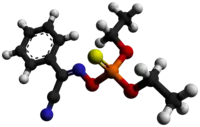Phoxim
Phoxim is an organophosphate insecticide that is produced by the Bayer corporation. It is an analogous dimethyl ester and an organothiophosphate acaricide. It is allowed for use in limited applications in the European Union.[2] It is banned for use on crops in the European Union since 22 December 2007.[3]
 | |
 | |
| Names | |
|---|---|
| IUPAC name
(E,Z)-N-[(Diethoxyphosphorothioyl)oxy]benzenecarboximidoyl cyanide | |
| Other names
Baythion Valexone Phoxime Sebacil Valexon Volaton | |
| Identifiers | |
CAS Number |
|
3D model (JSmol) |
|
| ChemSpider | |
| ECHA InfoCard | 100.035.337 |
| EC Number |
|
| KEGG | |
| MeSH | Phoxim |
PubChem CID |
|
| UNII | |
CompTox Dashboard (EPA) |
|
InChI
| |
SMILES
| |
| Properties | |
Chemical formula |
C12H15N2O3PS |
| Molar mass | 298.30 g·mol−1 |
| Appearance | Brownish red liquid |
| Density | 1.17 g/cm3 |
| Melting point | 6.1 °C (43.0 °F; 279.2 K) |
| Boiling point | 102 |
Solubility in water |
7 ppm |
| Pharmacology | |
| QP53AE03 (WHO) | |
| Hazards | |
| GHS labelling: | |
Pictograms |
   |
Signal word |
Warning |
Hazard statements |
H302, H317, H361f, H410 |
Precautionary statements |
P201, P202, P261, P264, P270, P272, P273, P280, P281, P301+P312, P302+P352, P308+P313, P321, P330, P333+P313, P363, P391, P405, P501 |
Except where otherwise noted, data are given for materials in their standard state (at 25 °C [77 °F], 100 kPa).
Infobox references | |
It is used in veterinary medicine to treat ectoparasitic acarids.
This pesticide should be used with caution since some insects like Helicoverpa assulta become even more resistant when exposed.[4]
References
- "Phoxim PubChem entry". Retrieved 2008-07-06.
- Commission for Veterinary Medicinal Products; Phoxim Summary Report
- COMMISSION DECISION of 21 June 2007 concerning the non-inclusion of certain active substances in Annex I to Council Directive 91/414/EEC and the withdrawal of authorisations for plant protection products containing these substances
- Wang, Kai-Yun; Zhang, Yong; Wang, Hong-Yan; Xia, Xiao-Ming; Liu, Tong-Xian (2010-01-01). "Influence of three diets on susceptibility of selected insecticides and activities of detoxification esterases of Helicoverpa assulta (Lepidoptera: Noctuidae)". Pesticide Biochemistry and Physiology. 96 (1): 51–55. doi:10.1016/j.pestbp.2009.09.003.
External links
This article is issued from Wikipedia. The text is licensed under Creative Commons - Attribution - Sharealike. Additional terms may apply for the media files.